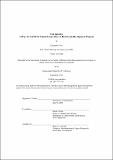| dc.contributor.advisor | David Geltner. | en_US |
| dc.contributor.author | Kim, Kyungwon | en_US |
| dc.contributor.other | Massachusetts Institute of Technology. Center for Real Estate. | en_US |
| dc.date.accessioned | 2010-09-22T15:56:15Z | |
| dc.date.available | 2010-09-22T15:56:15Z | |
| dc.date.copyright | 2008 | en_US |
| dc.date.issued | 2008 | en_US |
| dc.identifier.uri | http://hdl.handle.net/1721.1/58637 | |
| dc.description | Thesis (S.M. in Real Estate Development)--Massachusetts Institute of Technology, Dept. of Architecture, Center for Real Estate, 2008. | en_US |
| dc.description | This electronic version was submitted by the student author. The certified thesis is available in the Institute Archives and Special Collections. | en_US |
| dc.description | Includes bibliographical references (leaves 64-65). | en_US |
| dc.description.abstract | The practice of applying options theory to real estate investments has only recently begun. In particular, options in real estate are called "real options." Real options add value to real estate development projects by allowing developers to take advantage of positive aspects of the market and avoid negative conditions. There has not been much effort to rigorously quantify the value of applying flexibility to real-world development projects. In this paper, I will attempt to examine the impact of applying real options theory to a mixed-use development project, the "Parcl project," which consists of two office towers, a hotel, and a retail mall to gain better understanding of flexibility. This project is being constructed all at once based on predetermined assumptions about factors like rental rolls, sales price, and constructions costs. However, the deterministic model could result in a loss in case market conditions do not meet the assumptions set at the beginning. In this sense, applying real options such as phasing, deferring, and abandoning would be one of the ways to absorb the uncertainties in the market. This paper will try to figure out how much value real options can add to the project in terms of dealing with market conditions. For the analysis, the quantitative methods such as an engineering model and Monte Carlo simulation will be used. | en_US |
| dc.description.statementofresponsibility | by Kyungwon Kim. | en_US |
| dc.format.extent | 65 leaves | en_US |
| dc.language.iso | eng | en_US |
| dc.publisher | Massachusetts Institute of Technology | en_US |
| dc.rights | M.I.T. theses are protected by
copyright. They may be viewed from this source for any purpose, but
reproduction or distribution in any format is prohibited without written
permission. See provided URL for inquiries about permission. | en_US |
| dc.rights.uri | http://dspace.mit.edu/handle/1721.1/7582 | en_US |
| dc.subject | Architecture. | en_US |
| dc.subject | Center for Real Estate. | en_US |
| dc.title | Real options : a way to deal with market uncertainty in real estate development projects | en_US |
| dc.title.alternative | Way to deal with market uncertainty in real estate development projects | en_US |
| dc.type | Thesis | en_US |
| dc.description.degree | S.M.in Real Estate Development | en_US |
| dc.contributor.department | Massachusetts Institute of Technology. Center for Real Estate | en_US |
| dc.contributor.department | Massachusetts Institute of Technology. Department of Architecture | |
| dc.identifier.oclc | 315825944 | en_US |
